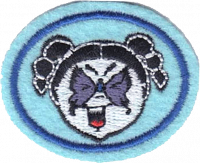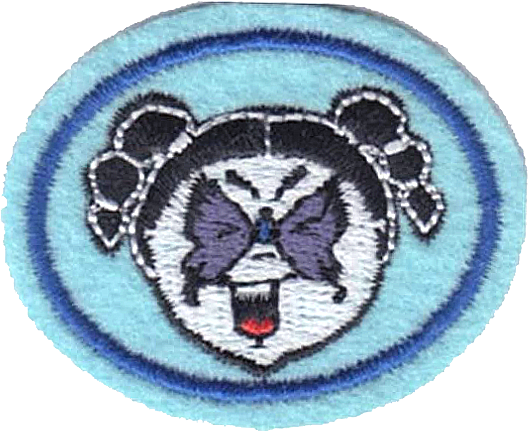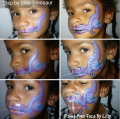Difference between revisions of "AY Honors/Face Painting/Answer Key"
(Marked this version for translation) |
|||
| Line 9: | Line 9: | ||
Face painting is the artistic application of cosmetic “paint” to a person’s face. | Face painting is the artistic application of cosmetic “paint” to a person’s face. | ||
| + | <!--T:31--> | ||
<b>''Religious/Ceremonial''</b><br> | <b>''Religious/Ceremonial''</b><br> | ||
People have used face paint as a means to express what they believed, that face painting with specific colours had special meanings and could be used as a spiritual tool. In many cultures, face painting is a deeply ingrained tradition, used in ceremonies, rituals, and celebrations. | People have used face paint as a means to express what they believed, that face painting with specific colours had special meanings and could be used as a spiritual tool. In many cultures, face painting is a deeply ingrained tradition, used in ceremonies, rituals, and celebrations. | ||
| + | <!--T:32--> | ||
''Meaning and Symbolism:'' Patterns and colours can represent lineage, status, beliefs, and spiritual connections. Eg Geisha / Amazonian tribes view face painting as a symbol of transforming oneself into something else, setting humans apart from animals. | ''Meaning and Symbolism:'' Patterns and colours can represent lineage, status, beliefs, and spiritual connections. Eg Geisha / Amazonian tribes view face painting as a symbol of transforming oneself into something else, setting humans apart from animals. | ||
| + | <!--T:33--> | ||
<b>''Entertainment/Performances''</b><br> | <b>''Entertainment/Performances''</b><br> | ||
Face painting became common in historical times as part of the world of live entertainment. Many different groups of people got involved with elaborate face painting for the purposes of creating or enhancing a costume that was used in some type of arts performance. | Face painting became common in historical times as part of the world of live entertainment. Many different groups of people got involved with elaborate face painting for the purposes of creating or enhancing a costume that was used in some type of arts performance. | ||
| + | <!--T:34--> | ||
<b>''Artistic / Recreational''</b><br> | <b>''Artistic / Recreational''</b><br> | ||
''Self-Expression:'' Face painting offers a canvas for creative expression, allowing individuals to depict their mood, personality, or favourite characters or themes. | ''Self-Expression:'' Face painting offers a canvas for creative expression, allowing individuals to depict their mood, personality, or favourite characters or themes. | ||
| + | <!--T:35--> | ||
''Play and Fun:'' Face painting is a fun activity for children and adults, especially at parties, events, and festivals, enabling them to participate in imaginative play. | ''Play and Fun:'' Face painting is a fun activity for children and adults, especially at parties, events, and festivals, enabling them to participate in imaginative play. | ||
| + | <!--T:36--> | ||
''Themed Events:'' Events like Halloween, Mardi Gras, or Comic-Con often feature face painting as a fun and festive activity, allowing attendees to transform into their favourite characters or create themed design. | ''Themed Events:'' Events like Halloween, Mardi Gras, or Comic-Con often feature face painting as a fun and festive activity, allowing attendees to transform into their favourite characters or create themed design. | ||
Latest revision as of 15:39, 28 August 2025
1
Face painting is the artistic application of cosmetic “paint” to a person’s face.
Religious/Ceremonial
People have used face paint as a means to express what they believed, that face painting with specific colours had special meanings and could be used as a spiritual tool. In many cultures, face painting is a deeply ingrained tradition, used in ceremonies, rituals, and celebrations.
Meaning and Symbolism: Patterns and colours can represent lineage, status, beliefs, and spiritual connections. Eg Geisha / Amazonian tribes view face painting as a symbol of transforming oneself into something else, setting humans apart from animals.
Entertainment/Performances
Face painting became common in historical times as part of the world of live entertainment. Many different groups of people got involved with elaborate face painting for the purposes of creating or enhancing a costume that was used in some type of arts performance.
Artistic / Recreational
Self-Expression: Face painting offers a canvas for creative expression, allowing individuals to depict their mood, personality, or favourite characters or themes.
Play and Fun: Face painting is a fun activity for children and adults, especially at parties, events, and festivals, enabling them to participate in imaginative play.
Themed Events: Events like Halloween, Mardi Gras, or Comic-Con often feature face painting as a fun and festive activity, allowing attendees to transform into their favourite characters or create themed design.
2
- Face Painting Paints
- Brushes - Round face painting brush / Flat face painting brush
- Face painting sponge
- Face Painting glitter / diamanté stickers
- Cups of water
- Baby Wipes
- Face painting sample chart
- Palette or plate for mixing colours
- Mirror
3
- Use the right product
- Keep your tools clean
- Use clean water
- Keep your hands clean
- Keep face painting kit clean
- Do not paint over damaged skin or wounds
- Make sure you are painting over clean skin
- Only use safe glitter, not craft glitter
- Your health matters
4
5
6
7
- Tear Drop
- Reverse Tear Drop
- Thin Lines
- Thick Lines
- Swirls
- Double Swirls
- Tiger Lines
8
10
11
12
12a
As in water face reflects face, So a man’s heart reveals the man.
12b
And do not think you can say to yourselves, 'We have Abraham as our father.' I tell you that out of these stones God can raise up children for Abraham.
References












